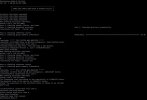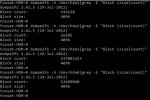HUMAX FOXSAT HDR
After many years of fautless service about 2 weeks ago my HUMAX started behaving oddly.
It was operating with what was the last officially supplied firmware (from 2012?).
It would work for a while (10-15 minutes) and then when I changed channel it would go to a black screen (displaying the new channel info in the box at the bottom for a few seconds).
The screen remained black, neither the remote or the front panel buttons had any effect and only a power cycle by the mains switch on the rear left would have any effect.
Once power cycled it would work perfectly for another 10-15 minutes before the fault reoccurred in exactly the same way and continued to repair.
I opened the box and checked that the fan was working (I suspected overheating) and that involved pulling the HDD.
The fan was working well (although it is hardly blowing a gale).
After reassembly there was no change in behaviour.
I then wondered if there might be a HDD issue and as the 1TB drive was >50% full I got sidetracked into trying to access the files without doing USB downloads and that led me to the Custom Firmware 4.1.3 upgrade which I did successfully via a USB stick in the front socket.
Having connected the box to my router I then downloaded everything I wanted via the web interface and deleted everything from the HDD.
I then reformatted the HDD via the HUMAX user interface.
On first reconnecting the box to the TV everything seemed better but a different issue is now occurring.
Now after about 10-15 minutes the video freezes. Shortly after that the audio goes and only a power cycle by the mains switch on the rear left has any effect.
Of course I cannot be sure what the reason for the change in the fault behaviour is. It could be:
1) The firmware upgrade
2) The fact that the HDD has been emptied and reformatted
The only reason I can think why a HDD fault would be an issue would be tied in to the fact that the box records "the last two hours" of any channel it is on and if it is struggling to do this then this could ultimately lead to some sort of "buffering" issue (using the term in it's loosest sense) that eventually crashes the box.
I was considering swapping the HDD (respecting the 1 TB limit) and I do have a few spare drives (all bigger than 1TB of course).
I was wondering if anything like this has been seen before and if there's anything else I could try.
I have some engineering experience but software (Filezilla, telnet etc.) is not my speciality so if there's anything simple I can try to rectify the issue.
Finally other than the 1TB limit and a 3 GB/s read/write speed limit is there anything else I should consider in terms of the spec?
I did read something about not buying a PC HDD because error checking slows the write speed down the write speed which causes issues.
Thanks in advance for your help.
After many years of fautless service about 2 weeks ago my HUMAX started behaving oddly.
It was operating with what was the last officially supplied firmware (from 2012?).
It would work for a while (10-15 minutes) and then when I changed channel it would go to a black screen (displaying the new channel info in the box at the bottom for a few seconds).
The screen remained black, neither the remote or the front panel buttons had any effect and only a power cycle by the mains switch on the rear left would have any effect.
Once power cycled it would work perfectly for another 10-15 minutes before the fault reoccurred in exactly the same way and continued to repair.
I opened the box and checked that the fan was working (I suspected overheating) and that involved pulling the HDD.
The fan was working well (although it is hardly blowing a gale).
After reassembly there was no change in behaviour.
I then wondered if there might be a HDD issue and as the 1TB drive was >50% full I got sidetracked into trying to access the files without doing USB downloads and that led me to the Custom Firmware 4.1.3 upgrade which I did successfully via a USB stick in the front socket.
Having connected the box to my router I then downloaded everything I wanted via the web interface and deleted everything from the HDD.
I then reformatted the HDD via the HUMAX user interface.
On first reconnecting the box to the TV everything seemed better but a different issue is now occurring.
Now after about 10-15 minutes the video freezes. Shortly after that the audio goes and only a power cycle by the mains switch on the rear left has any effect.
Of course I cannot be sure what the reason for the change in the fault behaviour is. It could be:
1) The firmware upgrade
2) The fact that the HDD has been emptied and reformatted
The only reason I can think why a HDD fault would be an issue would be tied in to the fact that the box records "the last two hours" of any channel it is on and if it is struggling to do this then this could ultimately lead to some sort of "buffering" issue (using the term in it's loosest sense) that eventually crashes the box.
I was considering swapping the HDD (respecting the 1 TB limit) and I do have a few spare drives (all bigger than 1TB of course).
I was wondering if anything like this has been seen before and if there's anything else I could try.
I have some engineering experience but software (Filezilla, telnet etc.) is not my speciality so if there's anything simple I can try to rectify the issue.
Finally other than the 1TB limit and a 3 GB/s read/write speed limit is there anything else I should consider in terms of the spec?
I did read something about not buying a PC HDD because error checking slows the write speed down the write speed which causes issues.
Thanks in advance for your help.









